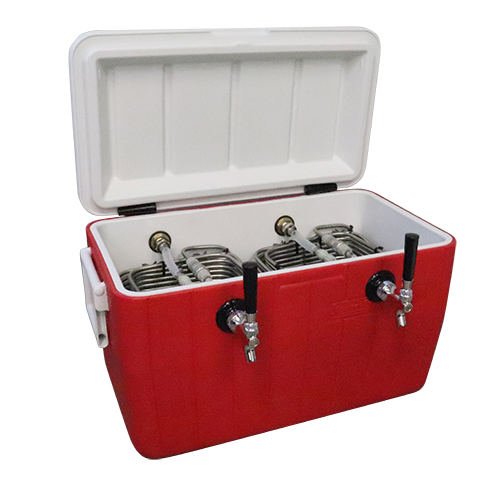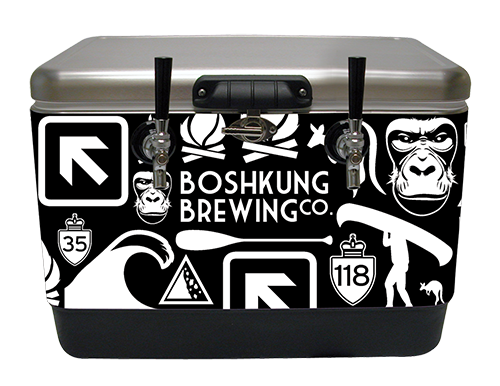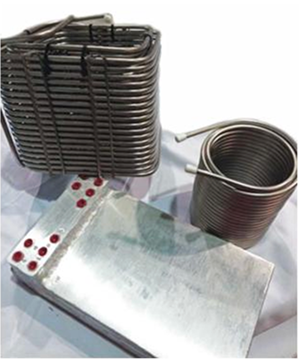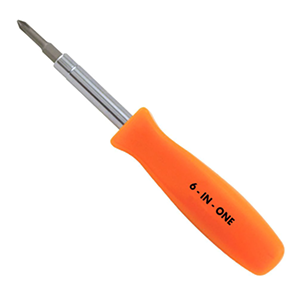Beer Fest & Chill
A Masterclass on Jockey Boxes
Author: Dan Broaddus
As our summers begin to return to normal, I envision a mash* of summer festivals, spanning from the May long weekend to Oktoberfest, with little to no pause betwixt. With festival season back in full swing, you may find your team attending multiple festivals every weekend… and even during the week!
I imagine this busy festival season blending into one strange monster: a foamy-haired, moustachioed beast that reeks of dry hopped sours, pomade, and artisan sausages made from hand-raised middle-white pork. This elevated swine was hand raised, and carried about on a covered, sedan chair, by gelded wolverines. Such a magical pig was surely fed only foie gras, arctic kelp, and grizzly bear milk. Finally, the sausage was cold smoked over artisanal charcoal in the skull of a whale that was ethically harvested by Inuit, living in the traditional way. Yours for only $48. Bun extra.
Whatever shape the season takes, Jockey Boxes will abound. Keep in mind, many of them may have been in storage since the Before Times, or seen only light use in recent seasons. Some will just need a good clean. Others will need an overhaul.
The rest will need a shallow grave, and maybe an “In Memoriam“ Instagram post, or a TikTok of an Office-Space-Style beat down. Or, mayhap, you are a newb to the Festival/Event side of the business, and need guidance in the acquisition of such a device.

Hell, you might not even know what a Jockey Box is (unlikely for Brewery types…) But where to begin...and how?
The Jockey Box: Star of Festival Season
Just in case you don’t know what a Jockey Box is (except for the visual provided by the accompanying photo,) a Jockey Box is a cooler, or other bin, used to flash chill beer or other beverages. Generally, they can be found in a setting where one cannot use a refrigerator, potentially even being without electricity. Hence, its popularity at festivals.
Most commonly, a Jockey Box comprises of a chest cooler in the 45-55 qt/L size range, with 1-4 beer faucets. The idea is that, even if your product is warm, the box can be used to make the beverage drinkable using ice, water, and some method of heat exchange. We will cover the mechanics in a bit, but for now let’s start where folks usually start: with the eye candy.
To Brand or Not to Brand
As stated, a picnic/camping cooler is most commonly used to house the chilling and dispense apparatus. There are a lot of options available, so first we need to ask a few basic questions. What level of fancy do you require? Are you particular about its material? Do you want it to be branded? Some units can be printed or decaled; others can be wrapped in vinyl. You can permanently brand the lid, and include a chalkboard, whiteboard, or magnet-sign set up on the customer side.
Some folks don’t bother, choosing to rely on the tap handles for their visual appeal. I recommend some sort of generic, but quality, branding, noting your brewery or business name… if for no other reason than making it less likely to go home with another Brewery, rental agency, or event company. After all, every other company has the same, plain red, blue or stainless steel cooler. It’s hard to prove It’s yours, once It’s in someone else’s van!
Check your Style
Some people go with retro coolers, or the big, roll around, stand-up ice tubs. I’ve seen horse troughs, or the insulated poly bins they use in commercial and industrial food production. I’ve even seen people use plain, uninsulated storage tubs.
The bottom line is that if the cooler or bin can fit a coil or plate, and hold some ice, it can flash chill. But all are not created equal. “Marine Grade” coolers store ice the best, but remember: most of the melt-heat will come from the product itself. Regardless, if the event is exceptionally warm, sunny, remote, or long in duration, marine grade can help you stretch your ice.
They also tend to be the most durable….and expensive. Regular, trusted brands of coolers that are designed for picnics and camping, such as Coleman, Igloo, Rubbermaid, or their equivalent, are usually sufficient for dispense.

Just be wary of knock-offs that are significantly less expensive, as these often have very poor insulation, are prone to sweat a lot, and may fall apart after only one season of use. Invest in a brand and name you trust, and keep in mind there will be no warranty the second you put a hole in it, unless the warranty is offered by the person who built the box out for you. Don’t pay for any warranty you don’t have to, and if you can get your cooler gently used, or scratch and dent…all the better.
Ice, Ice, Baby
Another thing to consider is buying a durable, but attractive, cooler for dispense, and splurge on a large marine grade cooler to store your extra ice. If the event doesn’t offer ice service, and you are the one that will be hauling ice in from wherever, I recommend buying the cooler rated for marine or extreme use. It’s worth it.
For this application, something in the 80-120 QT range with wheels will be your best friend. These high-end marine coolers cost a lot, but if you buy them on clearance at the end of the season, you can save a few bucks. Unlike a regular picnic cooler, they can keep ice frozen for 5-10 days, if managed correctly.
At the end of a busy and hot season, the amount of money you save in ice, and in fuel or fees to go get more ice, and time lost promoting and selling because someone has to go for ice….you get the picture. A marine cooler for ice storage will likely pay for Itself halfway through your first, full season. And you can get it branded, keep your food in it, and it makes a great bench.
Size Does Matter
Another important consideration is the size of Jockey Box you will require. In this case, the old adage holds true… size does matter. Ask yourself a few questions to determine the best size to suit your needs. How many different beers do you want to pour from this Jockey Box? What kind of volume do you expect to do? How difficult will ice supply be? Last, what is the temp differential expected to be?
There are a few factors to consider as to number of offerings. How big a cooler do you want to have to deal with? Think of the physically weakest person in your organization who might need to move this thing around. Will they be able to? Remember, these units get heavy, quick. Fully loaded, an average 2 faucet, 54 QT, steel belted Jockey Box will weigh between 100 and 150 pounds. This is roughly equivalent to a 50L keg.
Also, you will require a stout platform to put it on. Make sure your table or cart is rated to support 500 pounds, because at some point, a 300-pound brewer, in Wellington boots and overalls, will be leaning on this box or table. And this doesn’t account for the weight of their beard, moustache wax, pomade, ego, regret, and self-doubt...in short, buy or build a strong stand.
Personally, I would recommend a cart with large tires, like you find on a garden wagon. You can skirt it, or place a cabinet under it, creating the perfect location for your kegs and CO2 cylinders, along with a tool kit.
Coil Considerations
Now, let us say that a customer called me, looking for a 4 Product Jockey Box in a standard cooler format. They expect to pour a lot of 4-6 oz samples of 2 of the beers, and half or fewer samples of the other 2. They don’t wish to buy a massive cooler because it won’t fit in a regular car, or the salesperson can only lift and carry about 50 lbs, and they will work out of 20 L kegs.
For this scenario, I would prescribe a pair of 120 ft coils (pictured upper left) and a pair of 50 ft coils (pictured on the right.) If usage was to be moderate to light, and fairly even between products, I might go with a chill plate, as seen across the bottom.

Chill plates stay cold longer, but recover more slowly. Coils warm more quickly, but recover almost instantly. And as you can see, not all coils are created equally. Both pictured coils are 304 Stainless Steel, 5/16” O.D. restricting at 0.3 lbs/ft. Both are also a double-coil. The primary differentiator between the two are the spacer “combs” on the 120 ft coil.
These spacers allow ice water to flow between the coils, creating a more even temperature and more surface contact between the ice water and stainless steel. The 50-footer is built to be compact, so this spacing is sacrificed, along with some of the efficiency and overall consistency of performance. If you can manage it, groovy. It is about function.
An additional advantage of the coil-in-coil approach is a lower dry weight. Once Ice and product are removed, you shave about 15 lbs by going with coils.
Materials Matter
All metal components, through which the product travels, should be made of 304 or 316 stainless steel. This includes the keg coupler probe, all tailpiece fittings at coupler, shanks which pass through the walls of the cooler, and perhaps most importantly, the faucets.
Beverage soft jumper lines, from keg to box, and from shanks to cooling apparatus, should be both flexible and long enough to allow easy cleaning and shifting of components. Quick release devices are also helpful, in this regard.
Gas tubes should be reinforced hose, rated for at least 120 psi. The hoses used most commonly have a 60 psi rating. Remember that all of these ratings are based on a 20°c/72°f or colder ambient temperature, and no direct sunlight. These hoses have been known to do an impression of unsliced bologna, from time to time, with just a little extra heat.
Beer Gas & Beyond
Use pure CO2 for beer unless it is specifically a nitro beer such as Guinness, Boddington’s, Murphy’s, etc. Most of these flash chill devices require pressures of 24-36 PSI just to overcome internal restriction values created by the plates and coils. And you are correct in thinking that such pressures of pure CO2 would normally over-carbonate your beer. That is, you are correct… if the beer is cold. At these events, even if your kegs are stored cold, they are often stored at 4-6°C/40-44°F. If you try to pour a draft at these temps, foam city.
What’s more, once the keg is dropped to your booth, it will begin to warm. A keg at 19°C/66°F needs a keg pressure of 30-34 PSI, just to maintain a carbonation level of 2.5 volumes. And for every 1000 feet of elevation, add half a pound to that.
Additionally, you can fit many times the amount of CO2 into a cylinder as nitrogen or nitro blends. The expansion rate of CO2 is nearly 3 times that of nitrogen, since CO2 stores as liquid in a cylinder. A 10L cylinder of CO2 can dispense up to 3000L of beer at 28 psi. The same beer gas would do about 1660L. Plus, it often costs 2-3 times as much. This means you can haul nearly twice the amount of pure CO2 for the same amount of space, and save hundreds of dollars on the gas alone. With all that spare space and cash, you can bring more ice.
Clean is King
Rinse out the product lines after each day’s use, and chemically clean the lines between events. Cap or bag faucets and couplers when not in use.
Avoid coils which are welded, soldered, or brazed, as it is impossible to ensure that the interior of the weld is seamless and smooth. Most of these welds are made by flaring one of the tube ends to overlap the other, followed by heating the pipe and sealing the overlap with a filler alloy that melts at a temperature which is high for solder, but low for welding.

Plumbers call this technique “sweating”. The issue is that the end of the interior pipe is butted to the angled, interior wall of the flared pipe end. This gap (seen above in green) is the perfect place for gunk to build up. This can also create a turbulent eddy within the pipe that results in excess foam. Sanitary double flare fittings are acceptable, but the best join on a product is no join at all.
Several companies produce coils that are of a single, contiguous tube, with spacer combs, and if long enough, is doubled on itself. There is no reason to include points at which leaks, flow disruptions, or potential microbiological festering might occur. Keep it simple. Don’t punish yourself because a particular manufacturer is unwilling to evolve.
Keepin’ It Cool
If the event is likely to be extra hot, and your keg temperatures risk exceeding 30°C / 90°F, you will definitely need ice tubs for the kegs. It also wouldn't hurt to bring some rock salt along. On those rare occasions where the heat is so high that Jockey Boxes can't chill the beer enough, even with an iced keg, salt will increase the thermal conductivity between
the water and the keg, drawing more heat out than would otherwise be possible with ice water alone.
Make sure to use ice water, not just ice. Ice has pretty poor packing efficiency, and the name of the game for heat transfer is "surface contact.” Even with ice that packs efficiently, your best bet on beer line surface coverage is about 40-50%. With ice water, it is 100%, and you can also use larger pieces of block ice in the more open areas of the cooler. I'm a fan of freezing baggies or balloons full of water, to make giant, solid ice balls. You can also freeze your water bottles, and drink them once thawed.
On the Road Again
You may need to travel quite the distance to arrive at the summer’s festivals. It is important to ensure you have reliable transportation…and a plan if that transportation breaks down. To this end, acquire a roadside assistance plan for every vehicle, make sure it is up to date, and covers a long tow.
To transport your supplies after arriving at the event, bring along a sturdy cart or garden wagon with balloon tires. Not all venues allow you to pull right up to the booth, and even if they do, it’s only at the beginning and end of the event. Plus, there might be a long queue to get your car in and out, or you might have multiple vehicles to unload. You might also have a team member who gets extra festive, and needs a pull to the washroom or to the first aid station. Trust me… you don’t want to carry them.
Ensure you have a secure way to transport and store your CO2. If a CO2 cylinder falls over and cracks, or the valve head is broken or sheared off, the CO2 in the cylinder is going to start to violently boil, forcing the gas out of the break at 1050 PSI.
It doesn't matter if it is steel or aluminium, it is deadly. Aluminium cylinders travel faster. Steel cylinders have more mass, so they hit harder. Either one can easily travel clean through a cinder block wall and lodge itself in another cinder block wall across a room. What do you think it might do to a human? Invest in a bungee cord, ratchet strap, or chain of some sort. It might save your life.
High Quality H2O
I’m giving this its own category because it is so important. You will need to bring 4L (or 1 gallon) of drinking water per day, per person working the event. This water is ONLY FOR DRINKING, to make coffee and tea, and for brushing teeth. Washing and cooking water must be separate. While normal guidelines are 2L of water per day for an adult, remember you will be drinking, working 12 or more hours at a shift, physically exerting yourself, and likely out in the heat. You will need at least 3L, and the rest is a buffer…for Murphy.
At the Mercy of Murphy
I am of the school of Murphy, who states: “Given any possible chance, anything that can go wrong, will go wrong.” I design, load, and build with this in mind.
Festivals vary, as far as keg storage. Best case, your kegs are in a proper, 2°C/36°F fridge, and are delivered to you, on demand, at a moment’s notice. There are also tubs of unlimited ice, reliable power, and reach-in refrigerators at your station, allowing you to keep the beer cold for the life of the keg. Oh...and all of this is included in the reasonable vendor fee you paid several months/weeks prior.
Worst case, it’s the craft festival equivalent of the Bloodsport Kumite but held in Thunderdome.
Reality is usually something just south of a halfway between these two scenarios. To be safe, I never count on any ice or CO2 gas I don’t bring. I further assume that I will need to be able to flash chill beer that is the same temperature as the outside air, whatever that is. This means I buy a Jockey Box design that can do it.
Such a Jockey Box usually comprises of 120’ coils with combs, and a secondary marine grade cooler or two, just for ice. I also locate every business that sells Ice within a reasonable drive. The ones that are easy to find, I will call and warn of the festival. The hidden ones, I keep to myself, and maybe make a hedge buy on spec.
Always Be Ready
Bottom line, whatever amount you expect to need, add 20%-25%. This is true for everything: ice, product, ice, business cards, ice, flyers, ice, merch, ice, CO2, ice, food and snacks for you and your staff, ice, toilet paper, ice, sunscreen, ice, bug spray. And don’t forget…extra ice.

Buy the type of regulator wrench that cannot be removed while the reg is attached to the bottle. If you don’t, Murphy will rain down his vengeance, and your crescent wrench or slip joint pliers will go missing on day 1 of a 4-day event…which is 1.5 hours’ drive to the nearest shop where you can buy a new wrench. Or you can spend $3 for a Wrench that cannot walk away. Guess what my vote is.
Make sure your regulator has a gauge guard. Gauges are fragile and can be broken internally, or even sheared off, should someone knock over the cylinder. Gauge guards are $10-$25. A new regulator is $65-$100, plus lost gas, lost sales, lost time, and lost fuel/shipping.
Have more tools available than you think you will need. This includes 2 faucet spanner wrenches, 3 adjustable wrenches/slip joint pliers, 2 universal screwdrivers that have #2 and #3 flat and Philips, as well as 1/4” and 5/16” hex drivers. Make sure you have any specialty drivers you might need, like Allen, Torx or Robertson drivers. Finally, bring tools to repair and maintain all your other gear, such as your canopy, trailer, tent, etc.
Remember to Have Fun
All work and no play… you get it. Remember to schedule some fun! Allow everyone on your team at least one hour to have fun during the event. Create a schedule to keep things organized, and allow team members to switch time slots… but everyone takes an hour.
Not all of your potential networking opportunities are going to make it to your booth. So, get out there, try some beers, and hand out cards and jokes. I don't know about you, but I think this is a pretty amazing industry, filled with awesome, interesting humans. Don’t forget that fun is mandatory.
My biggest tip for festivals is to remember that you are surrounded by people with whom you share a lot of commonality. People who sympathize, or can empathize. People who love to help and be of service. Let them. Asking for help to succeed is less damaging to one's pride than failing due to stubbornness. I will trade a small embarrassment over an epic "it was all my fault, and I could have avoided it" failure any day. After all, John and Paul taught us that we get by with a little help from our friends.
If any of this is useful, feel free to name a beer after me. I like Wheats and Browns. Anything with layers of spice, reminiscent of Belgium or Bavaria speaks to my very soul. The cost of licensing is 20L. Just please, no green or clear glass for packaging!
Cheers,
Dan Broaddus
Technical Advisor
Canadian Beverage Supply & Chill-Max Beverage Solutions
*mash; Pun not only intended, but lovingly crafted, to feed off of your moans, eye rolls, and retchings. Dad Power, Activate!
